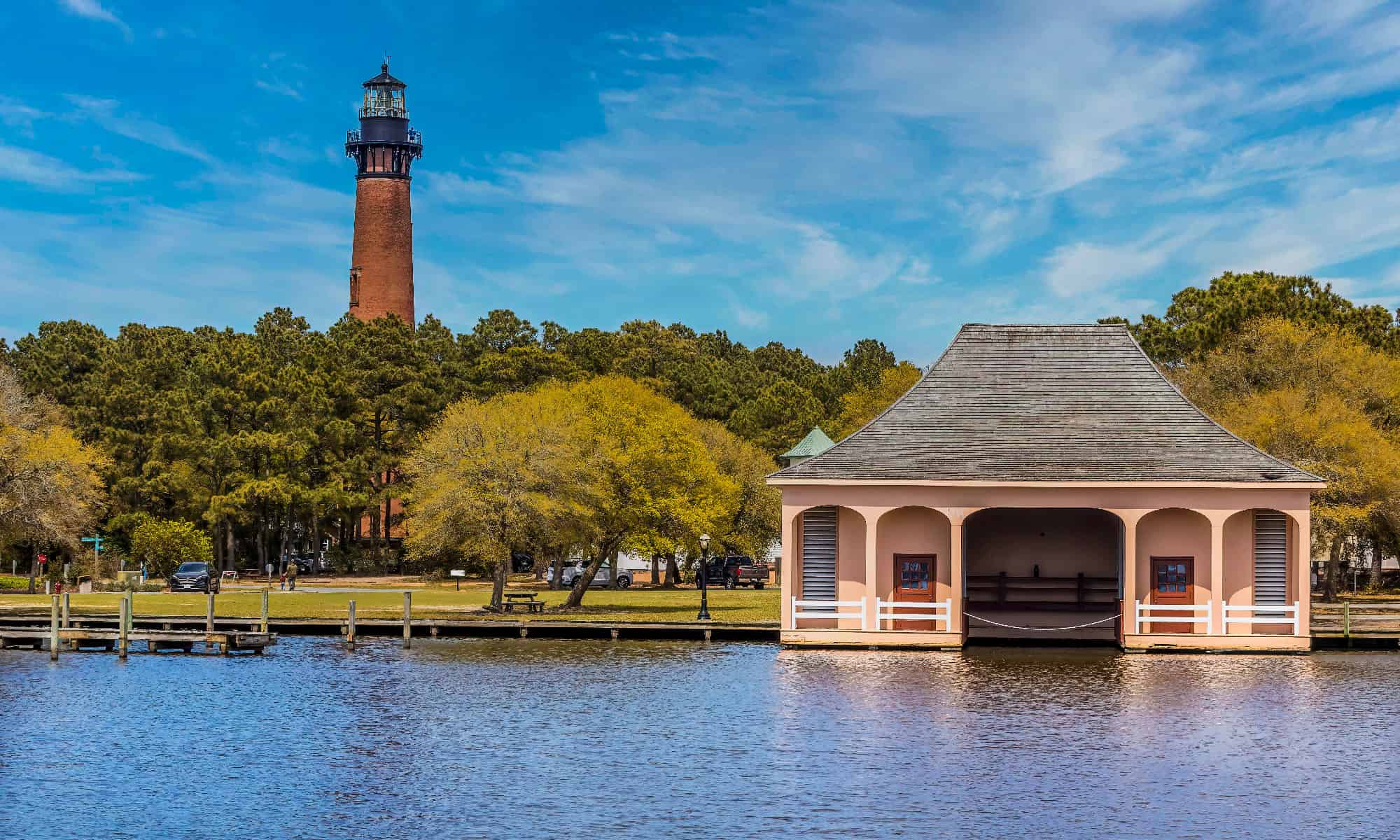North Carolina’s stunning coastline is home to some of the most picturesque lighthouses in the United States. With their rich history, magnificent architecture, and beautiful coastal views, these beacons of light have been guiding sailors safely to shore for generations. From the iconic Cape Hatteras to the lesser-known but equally enchanting Currituck Lighthouse, these eight lighthouses are sure to capture your imagination and impress you with their beauty. So let’s set sail and explore the eight most beautiful lighthouses in North Carolina, each with its own unique story and charm waiting to be discovered.

What is a Lighthouse?
Lighthouses have been used for centuries as navigational aid for ships at sea. The earliest known lighthouse was the Pharos of Alexandria, built in Egypt in the 3rd century BC. It was a tall structure, standing 450 feet (130 m) tall. It is considered one of the Seven Wonders of the Ancient World.
Over time, lighthouses evolved from simple fires on hilltops to sophisticated towers with powerful light sources. The use of lenses and mirrors to focus and reflect light significantly improved their effectiveness, making it easier for ships to travel through challenging waters.
Initially, lighthouses were operated by individuals who lived in the tower and manually maintained the light. However, with the advent of electricity and automation in the 20th century, most lighthouses became unmanned and remotely operated. Today modern navigational technology has all but rendered many lighthouses obsolete. However, they continue to serve as historic landmarks and tourist attractions, preserving the rich maritime history and heritage of coastal communities around the world.
While modern navigational technology is highly reliable, it’s always good to have a backup plan. In case of an emergency or a technological failure, lighthouses are reliable navigational aids to help guide ships to safety. Even when everything is on course, lighthouses serve as a beacon of hope and a reassuring presence to sailors who are navigating unfamiliar waters. Therefore, even in the age of modern technology, lighthouses still play an important role in maritime safety and navigation. Discover the seven most beautiful North Carolina lighthouses below.
1. Currituck
Currituck Beach Light is a historic lighthouse located in Corolla, North Carolina, on the Outer Banks. It is the northernmost lighthouse in North Carolina. Built in 1875, it is one of the most iconic lighthouses in North Carolina and is known for its distinctive red brick construction and light-colored base.
The lighthouse stands 162 feet (50 m) tall and has 220 steps to the top of the tower. Those who climb to the top enjoy panoramic views of the surrounding coastline and the Atlantic Ocean. It is unique among North Carolina’s lighthouses in that it is constructed entirely of red brick. This gives it a distinctive appearance and sets it apart from other lighthouses in the state.
Currituck Beach Light served as an important aid to navigation for more than 100 years. The light helped guide ships safely through the dangerous waters of Currituck Sound and the Atlantic Ocean. In the early days of the lighthouse, keepers would manually operate the light using a Fresnel lens. Fresnel lenses could be seen from a distance of up to 18 nautical miles. Today, the lighthouse is automated and operates using modern navigational technology.
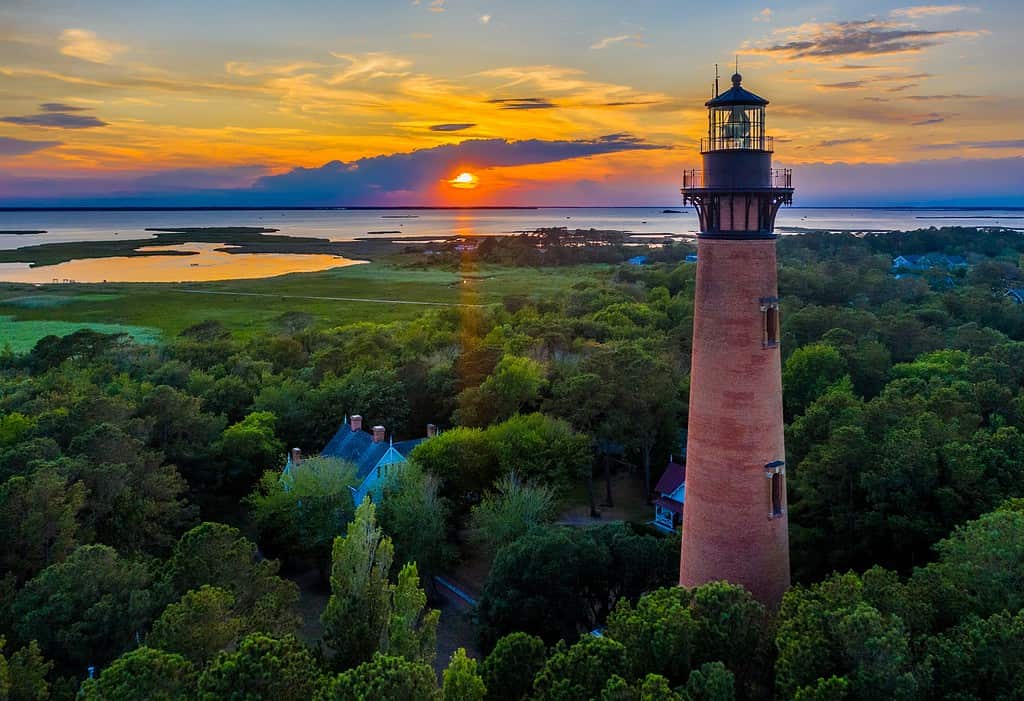
Currituck Beach Light is one of the most iconic lighthouses in North Carolina and is known for its distinctive red brick construction.
©Frederick Millett/Shutterstock.com
Wild Ponies
There is a 21-acre fenced pasture next to the Currituck Beach Lighthouse that is managed by the Corolla Wild Horse Fund. It serves as a sanctuary for the wild horses of the Currituck Outer Banks. The pasture provides a safe haven for pregnant mares and their foals. It also provides for injured or sick horses that require medical attention. The area is located adjacent to the lighthouse grounds.
The Corolla Wild Horse Fund works to protect and preserve the wild horses of the Outer Banks. Their efforts have been instrumental in ensuring that these iconic animals continue to thrive in the region. The origins of the Corolla Wild Horses are somewhat mysterious. It is believed that they are descended from Spanish mustangs. These horses were originally brought to the area by early European explorers and settlers. Over time, the horses have adapted to the harsh conditions of the Outer Banks and become a self-sustaining population.

The origins of the Corolla Wild Horses are somewhat mysterious, but it is believed that they are descended from Spanish mustangs.
©BHamms/Shutterstock.com
2. Hatteras
Cape Hatteras Light is a historic lighthouse located on Hatteras Island in the Outer Banks of North Carolina. Built in 1870, at nearly 200 feet (60 m), it is the tallest brick lighthouse in North Carolina.
It was constructed as a replacement for the original lighthouse that dated from 1803. The lighthouse is located on the Southern edge of the island. This is where the warm waters of the Gulf Stream meet the cool waters of the Labrador Current. This confluence creates an area known as the Graveyard of the Atlantic. It is characterized by its treacherous shoals and unpredictable weather patterns.
Cape Hatteras Light played a critical role in guiding mariners safely through these dangerous waters. It served as a crucial navigational aid for more than a century. In addition to its historical significance, Cape Hatteras Light is also known for its distinctive black and white spiral stripes. The spiral stripes make it one of the most recognizable lighthouses in the world. The spiral pattern was added to the lighthouse in 1873 to distinguish it from other lighthouses along the coast.
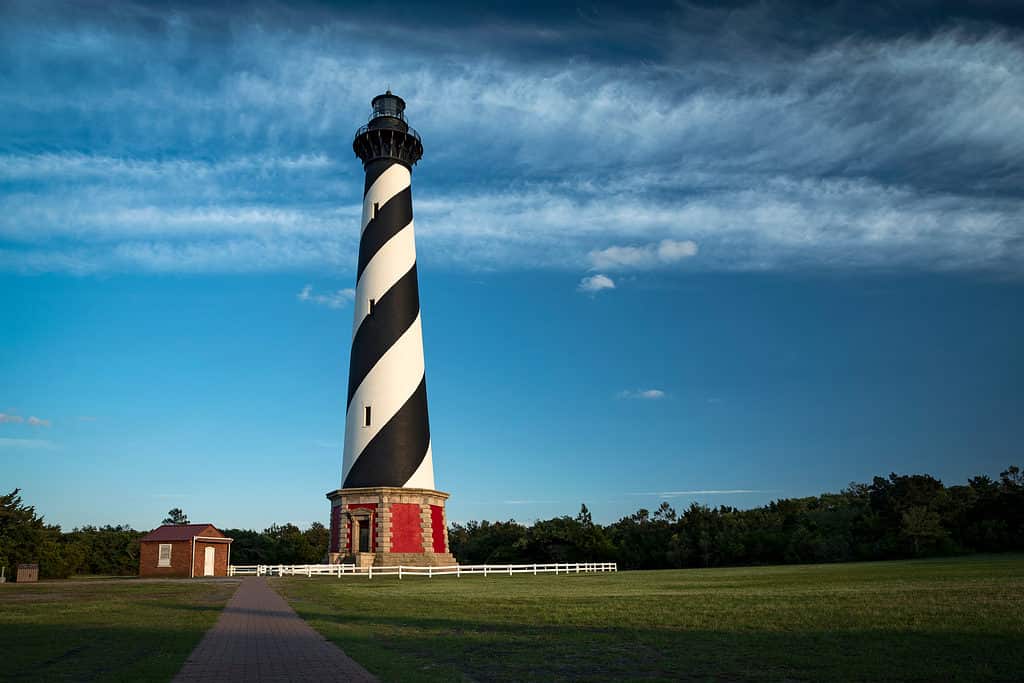
Cape Hatteras Light is also known for its distinctive black and white spiral stripes, which make it one of the most recognizable lighthouses in the world.
©Terry Costelloe/Shutterstock.com
Modern Challenges
Cape Hatteras Light is not presently (2023) open to the public as it is undergoing some much-needed restoration. The lighthouse is surrounded by a small park area. In addition, there are interpretive exhibits about the history of the lighthouse and the surrounding area. Despite its historic significance and popularity among tourists, Cape Hatteras Light has faced many challenges over the years.
The erosion of the island’s shoreline precipitated the need to move the icon in 1999. The lighthouse was moved 2900 feet inland to protect it from erosion, making it one of the most famous lighthouses in the world to be moved. The move was a massive engineering feat, requiring the use of hydraulic jacks and also a system of rails to transport the 4,800-ton (4354-metric-tonne) structure to its new location.
3. Roanoke Marshes Light
The Roanoke Marshes Light is a replica of an earlier lighthouse that once stood on the same site in Manteo, North Carolina. The original lighthouse was constructed in 1877 and served as a navigational aid for mariners traveling through the Roanoke Sound. Manteo is located on Roanoke Island, which was the site of the first English colony in the New World. The colony was established in 1587 and is known as the Lost Colony because its inhabitants disappeared without a trace.
The original lighthouse was decommissioned and demolished in 1955, and the site was left empty for many years. In the early 2000s, a local group of preservationists and historians began working to rebuild the lighthouse as a replica of the original structure.
The new Roanoke Marshes Light was completed in 2004 and now serves as a popular tourist attraction and museum. The lighthouse is located on the Manteo waterfront and is open to the public, providing visitors with an opportunity to learn about the history of lighthouses and navigation on the Outer Banks. Additionally, the replica lighthouse is constructed using materials and techniques that closely resemble those used in the original structure. It stands 40 feet (12 m) tall and features a distinctive red roof.
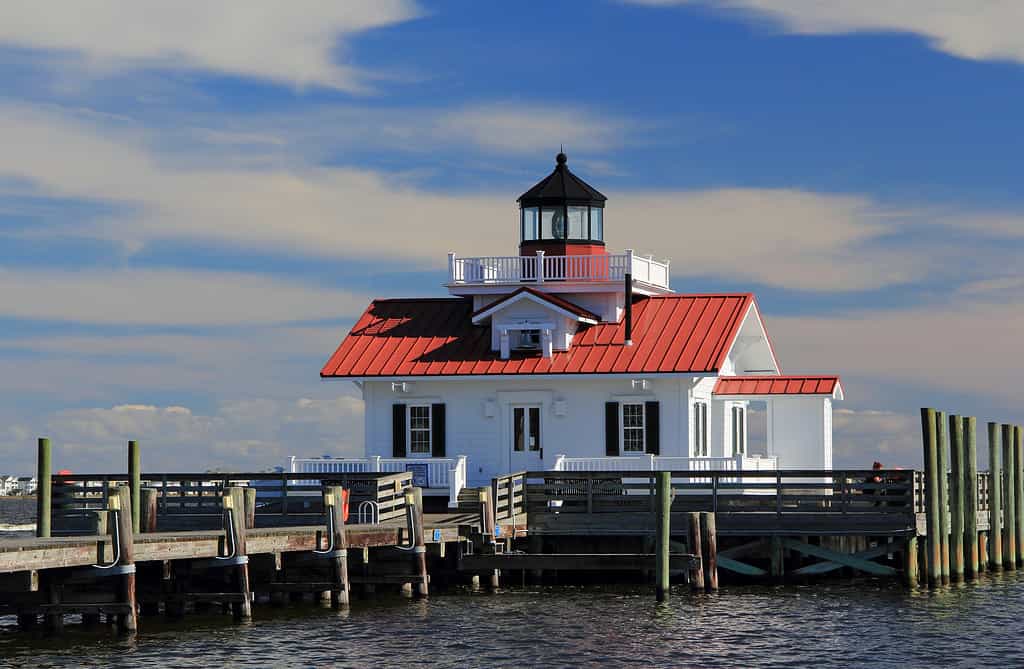
The replica lighthouse is constructed using materials and techniques that closely resemble those used in the original structure.
©William Silver/Shutterstock.com
4. Ocracoke
Ocracoke Light is a historic lighthouse located on Ocracoke Island in the Outer Banks of North Carolina. Built in 1823, it is the oldest operating lighthouse in North Carolina and one of the oldest in the United States. The lighthouse is situated on the Southern end of Ocracoke Island, where it served as an important navigational aid for mariners traveling along the Atlantic coast. Its light could be seen from up to 14 nautical miles away, helping ships safely navigate the treacherous waters of the Outer Banks.
Ocracoke Light is a distinctive white, conical tower that stands 75 feet (23 m) tall. Unlike many other lighthouses, it has never been painted, giving it a unique appearance that stands out against the surrounding landscape. The tower is made of bricks that are five feet thick! It is outfitted with a first-order Fresnel lens, which produces a powerful beam of light that is visible for miles.
In addition to its historical and navigational significance, Ocracoke Light is also a popular tourist attraction and a symbol of North Carolina’s coastal heritage. However, the lighthouse is not open for climbing.
Ocracoke Light has faced many challenges, including damage from hurricanes. However, it has been restored and maintained over the years by local organizations and government agencies, ensuring that it will continue to stand as a testament to North Carolina’s rich maritime history for generations to come.
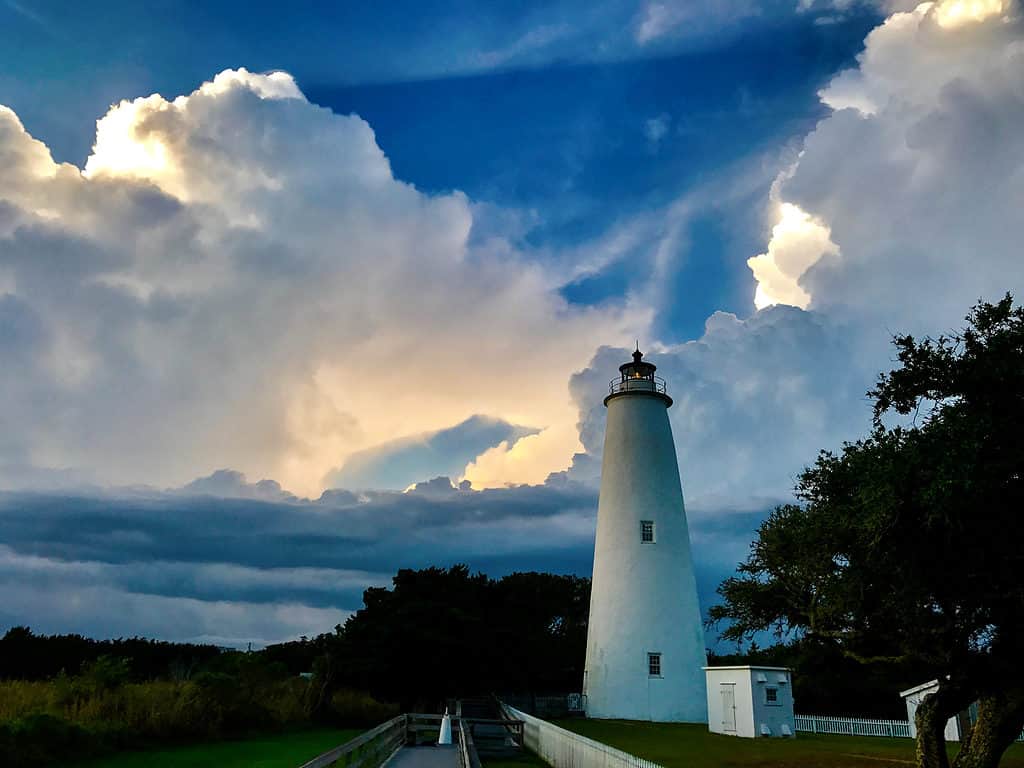
Over the years, Ocracoke Light has faced many challenges, including damage from hurricanes.
©ButtermilkgirlVirginia/Shutterstock.com
5. Cape Lookout
Cape Lookout Light is a historic lighthouse located on the Southern Outer Banks of North Carolina, on Harkers Island. The original Cape Lookout Light was commissioned in 1812. However, at just 96 feet(29 m), it was deemed too short to be an effective navigation guide. The current lighthouse, completed in 1859, is one of the most iconic lighthouses in the state and has become a symbol of North Carolina’s rich maritime heritage. The lighthouse stands 163 feet (50 m) tall and is made of brick and stucco. Unlike many other lighthouses in North Carolina, which are painted white or have distinctive patterns, Cape Lookout Light is painted in a black and white diamond pattern. This makes it easily recognizable from a distance.
History of Cape Lookout
Cape Lookout Light served as an important aid to navigation for more than a century. It helped guide mariners safely through the dangerous Diamond Shoals and other hazards off the coast of North Carolina. In the early days of the lighthouse, keepers would manually operate the light using a Fresnel lens. Today, the lighthouse is automated and operates using modern navigational technology.
In addition to its historical significance, Cape Lookout Light is also known for its picturesque location on Core Banks. The surrounding area features miles of pristine beaches and unspoiled natural beauty. It is a popular destination for beachgoers, hikers, and wildlife enthusiasts. Today, the lighthouse is open to the public for tours. However, climbing the tower has been suspended at least through 2025 as repairs are made to the structure. Cape Lookout Light is a true treasure of North Carolina’s coastal heritage.
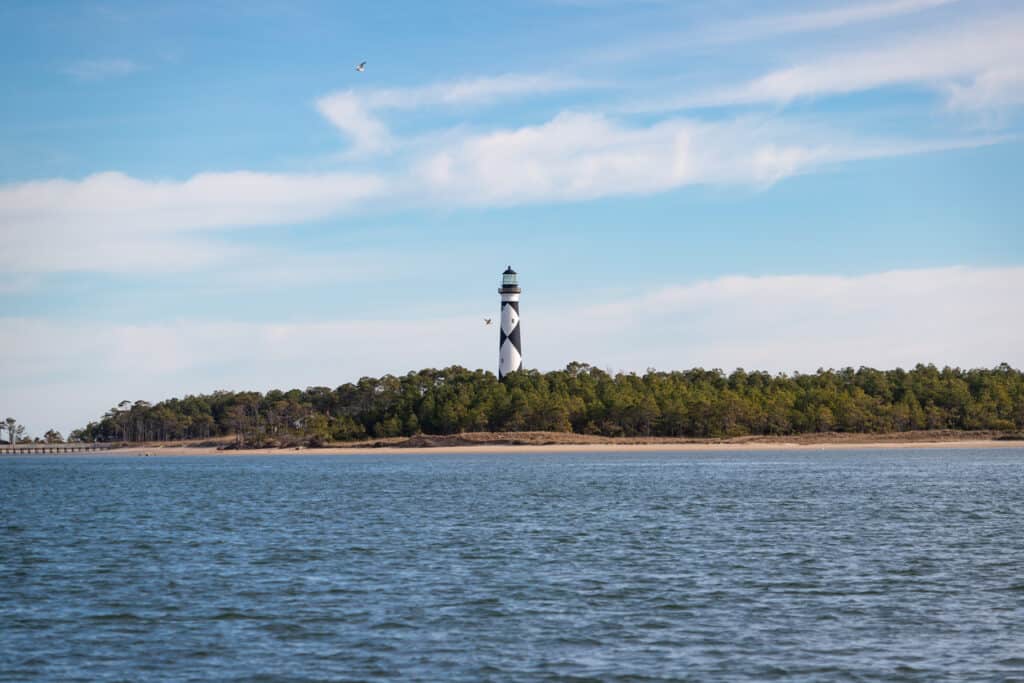
The Cape Lookout Lighthouse at Cape Lookout, North Carolina, viewed from the water.
©iStock.com/Eifel Kreutz
6. Old Baldy
Bald Head Light, also known as Old Baldy, is one of the most iconic lighthouses in North Carolina. Located on Bald Head Island, near the mouth of the Cape Fear River, it has been guiding mariners safely through the waters of the Atlantic Ocean for over 200 years. The original Bald Head Light was constructed in 1794. However, due to erosion and other factors, the tower was replaced in 1817. The current structure stands 110 feet (33.5 m) tall and is made of brick and stucco.
Bald Head Light is famous not only for its historical significance but also for its unique design. Unlike most lighthouses, which are cylindrical or conical in shape, Bald Head Light has a square base that tapers to an octagonal shape near the top.
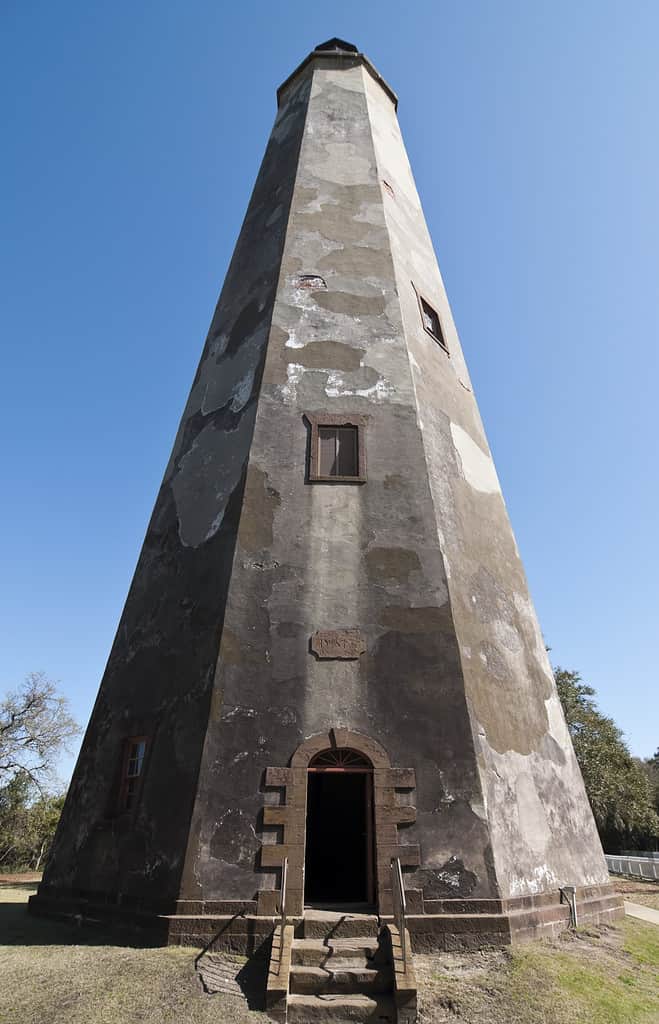
Unlike most lighthouses, which are cylindrical or conical in shape, Bald Head Light has a square base that tapers to an octagonal shape near the top.
©Katherine Welles/Shutterstock.com
Over the years, Bald Head Light has been the subject of many legends and stories. Tales of pirates, shipwrecks, and even ghosts are associated with the lighthouse. Today, the lighthouse and its surrounding area are a popular tourist destination, offering visitors the chance to climb to the top of the tower and enjoy panoramic views of the ocean and the surrounding landscape.
Bald Head Light is a true gem of North Carolina’s coastal heritage and a testament to the resilience of those who have worked tirelessly to maintain and preserve this historic landmark for future generations to enjoy.

Bald Head Light is a popular tourist destination, offering visitors the chance to climb to the top of the tower and enjoy panoramic views of the ocean and the surrounding landscape.
©iofoto/Shutterstock.com
7. Roanoke River Light
The Roanoke River Light is a historic lighthouse that is presently located in the harbor at Edenton, just north of the confluence of the Chowan and Roanoke rivers. The lighthouse was constructed in 1887 and originally stood in Albermarle Sound at the mouth of the Roanoke River. It served as a navigational aid for mariners traveling up and down the Roanoke River. The Roanoke River Light is a unique structure in that it is constructed of cast iron and wood, making it one of only a few such lighthouses in the United States. The lighthouse stands 42 feet (13 m) tall and features a distinctive black-and-white paint scheme, with a red roof.
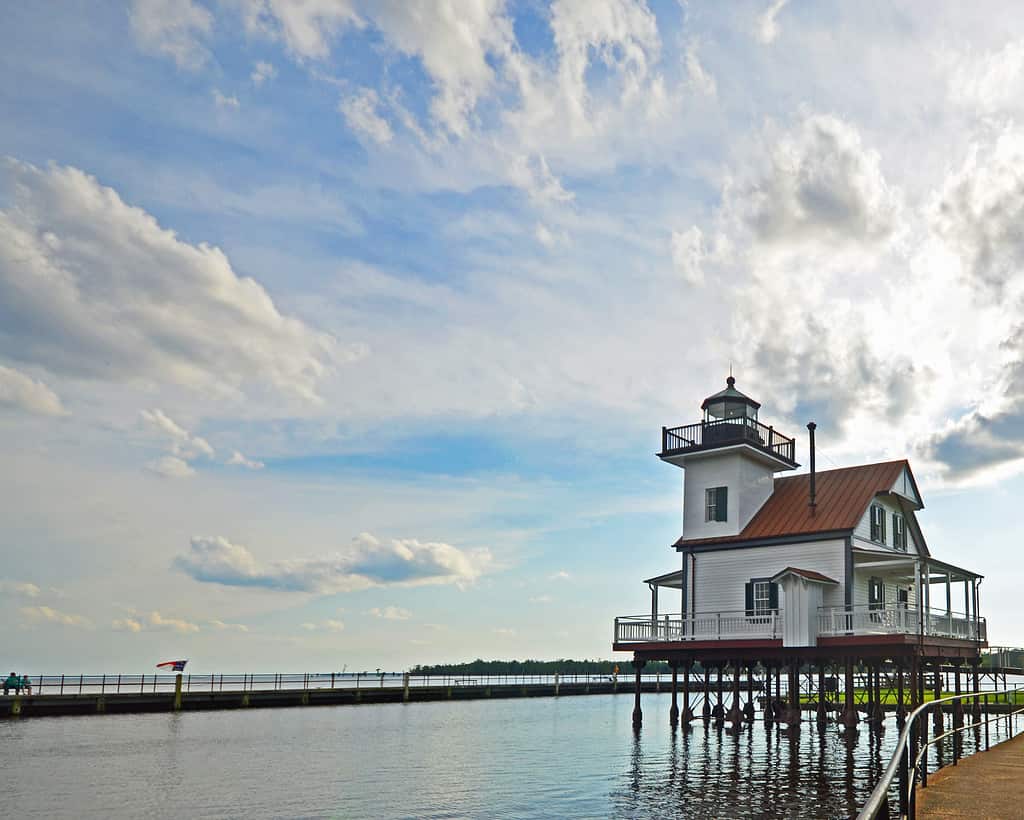
Roanoke River Light stands 42 feet (13 m) tall and features a distinctive black-and-white paint scheme, with a red roof.
©Gary J. Leasure/Shutterstock.com
The lighthouse was in operation until 1941 when it was decommissioned and replaced with modern navigational aids. The structure was then sold to a private individual and used as a residence for many years. In the early 2000s, the Roanoke River Light was acquired by the non-profit Roanoke River Lighthouse and Maritime Museum organization, with the goal of restoring and preserving the structure as a historic landmark. The restoration effort was completed in 2008, and the lighthouse is now open to the public for tours and educational programs.
Visitors to the Roanoke River Light can learn about the history of navigation on the Roanoke River, as well as the important role that lighthouses played in ensuring the safety of mariners. The lighthouse also features exhibits on the local wildlife and ecosystem of the Roanoke River. Today, the Roanoke River Light is a beloved landmark in the community of Edenton.
Summary of the Seven Most Beautiful North Carolina Lighthouses
| Number | Lighthouse | Location |
|---|---|---|
| 1 | Currituck Beach Light | Corolla |
| 2 | Cape Hatteras Light | Hatteras Island |
| 3 | Roanoke Marshes Light | Roanoke Island |
| 4 | Ocracoke Light | Ocracoke Island |
| 5 | Cape Lookout Light | Harkers Island |
| 6 | Old Baldy | Bald Head Island |
| 7 | Roanoke River Light | harbor at Edenton |
Thank you for reading! Have some feedback for us? Contact the AZ Animals editorial team.

